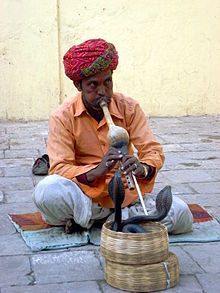Snake Charmers/Dancers
Snake charmer for hire
Girls have perfected taming Snakes with set routines and ambience dancing is performed with photo opportunities to touch or hold snakes, entertain guests of all ages. No need to be ssssssscared. Snake charmer for hire our super gorgeous snake charmers using 2 snakes and guest are welcome for photos, We are trained professionals





Interesting facts on Wikipedia Snake charmer for hire

Snake charming is the practice of appearing to hypnotize a snake (often a cobra) by playing and waving around an instrument called a pungi. A typical performance may also include handling the snakes or performing other seemingly dangerous acts, as well as other street performance staples, like juggling and sleight of hand. The practice was historically the profession of some tribesmen in India well into the 20th century but snake charming declined rapidly after the government banned the practice in 1972.[1][2] Snake-charmer performances still happen in other Asian nations such as Pakistan,[3] Bangladesh, Sri Lanka, Thailand and Malaysia. The tradition is also practiced in North African countries of Egypt, Morocco, and Tunisia.
Ancient Egypt was home to one form of snake charming, though the practice as it exists today likely arose in India.[citation needed] It eventually spread throughout South Asia, Southeast Asia, the Middle East, and North Africa. Despite a sort of golden age in the 20th century, snake charming is today dying out. This is due to a variety of factors, chief among them is the enforcement of the Wildlife Protection Act, 1972 in India banning ownership of snakes. In retaliation, snake charmers have organized in recent years, protesting the loss of their only means of livelihood, and the government has made some overtures to them. Snake charming is almost extinct in India.[1][4]
Many snake charmers live a wandering existence, visiting towns and villages on market days and during festivals. During a performance, snake charmers may take a number of precautions. The charmer typically sits out of biting range[5]: 251 and the snake is usually sluggish due to starvation or dehydration and reluctant to attack anyway. More drastic means of protection include removing the reptile’s fangs or venom glands, drugging the snake,[5]: 251 or even sewing the snake’s mouth shut. [6] The most popular species are those native to the snake charmer’s home region, typically various kinds of cobras, though vipers and other types are also used.
Although snakes are able to sense sound, they lack the outer ear that would enable them to hear the music. They follow the movement of the charmer and the pungi that the charmer holds with his hands.[5]: 251 The snake considers the person and pungi a threat and responds to it as if it were a predator.
History Snake charmer for hire
[edit]

The earliest evidence for snake charming comes from ancient Egyptian sources. Charmers there mainly acted as magicians and healers. Part of their studies involved learning the various types of snake, the gods to whom they were sacred, and how to treat those who were bitten by the reptiles. Entertainment was also part of their repertoire, and they knew how to handle the animals and charm them for their patrons.[citation needed]
One of the earliest records of snake charming appears in the Bible in Psalm 58:3–5: “The wicked turn aside from birth; liars go astray as soon as they are born. Their venom is like that of a snake, like a deaf serpent that does not hear, that does not respond to the magicians, or to a skilled snake-charmer.”
Snake charming as it exists today probably originated in India.[7] Hinduism has long held serpents to be sacred; the animals are believed to be related to the Nagas, and many gods are pictured under the protection of the cobra.
The earliest snake charmers may have been traditional healers by trade. As part of their training, they learned to treat snake bites. Some also learned how to handle snakes, and people called on them to remove snakes from their homes. Snake charming (or Baba Gulabgir) became their guru since his legend states that he taught people to revere the reptiles and not fear them.[citation needed] The practice eventually spread to nearby regions, ultimately reaching North Africa, South Asia and Southeast Asia.

The early 20th century proved something of a golden age for snake charmers. Governments promoted the practice to draw tourism, and snake charmers were often sent overseas to perform at cultural festivals and for private patrons. In addition, the charmers provided a valuable source of snake venom for creating antivenins.[citation needed]
The practice is no longer legal in India[8] following changes to the Wildlife Protection Act. The law was originally passed in 1972, and aimed at preventing the export of snakeskins, introducing a seven-year prison term for owning or selling snakes.[9] Beginning in the late 1990s, however, the law was also applied to the snake charmers. As a result, Indian charmers were forced to move their performances to less-travelled areas such as small villages or face legal action.
In 2003, hundreds of snake charmers gathered at the temple of Charkhi Dadri in Haryana to bring international attention to their plight.[10] In December of the following year, a group of snake charmers stormed the legislature of the Indian state of Odisha with their demands while brandishing their animals. The Indian government and various animal-rights groups have acknowledged the problem. One suggested solution is to train the performers to be snake handlers, capturing and removing venomous snakes from city and suburban gardens.[11] In return, they could sell their traditional medicines as souvenirs. Another proposal would try to focus attention on the snake charmers’ music and treat them like other street musicians.
